JUMP TO TOPIC
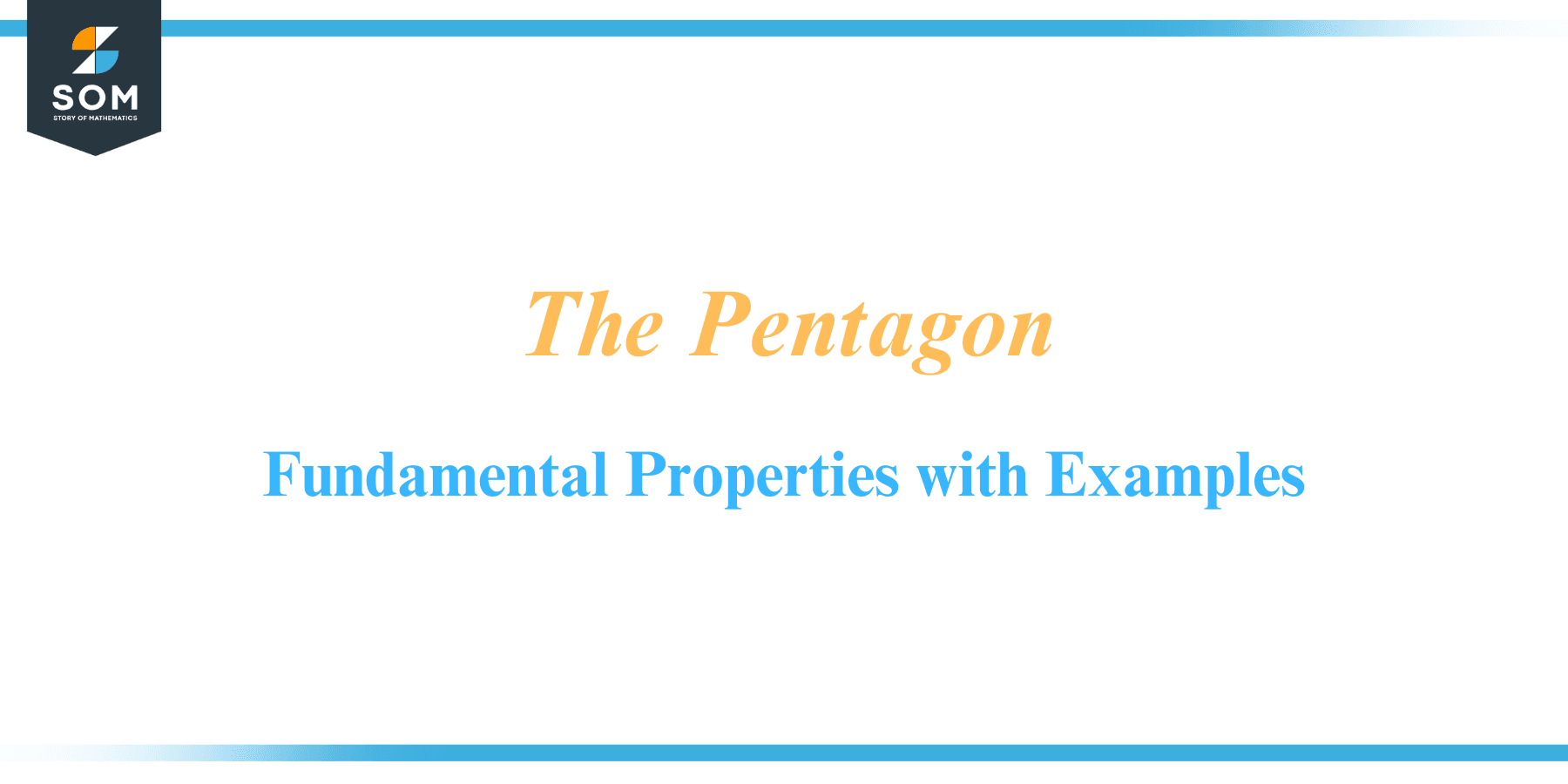
The Pentagon, as a geometric shape, is a polygon with five sides that holds a unique place in the realm of mathematics and geometry. Derived from the Greek words “penta,” meaning “five,” and “gonia,” meaning “angle,” the Pentagon is defined by its distinctive five straight sides and five interior angles. It’s symmetrical design and balanced proportions have intrigued mathematicians, artists, and architects for centuries. From ancient civilizations to modern-day structures, the Pentagon’s geometric elegance continues to inspire and captivate those who appreciate the beauty and precision of mathematical forms.
This post will examine the intriguing features, historical significance, and creative applications of the Pentagon as a geometric shape.
Definition
The Pentagon is a geometric shape that is characterized by its five sides and five angles. It is a polygon, which means it is a closed figure formed by connecting straight-line segments. The term “pentagon” is derived from the Greek words “penta,” meaning “five,” and “gonia,” meaning “angle.”
The five sides of a pentagon are straight lines that connect to form a closed shape. Each side of a pentagon intersects with two other sides, and a pentagon’s internal angles add up to 540 degrees. This means that each of the five angles in a pentagon measures 108 degrees.
The symmetry of a pentagon is evident as it can be divided into five equal isosceles triangles. The diagonals of a pentagon are line segments that connect non-adjacent vertices, forming internal triangles. A pentagon has a total of five diagonals. Below is the generic diagram of a pentagon.
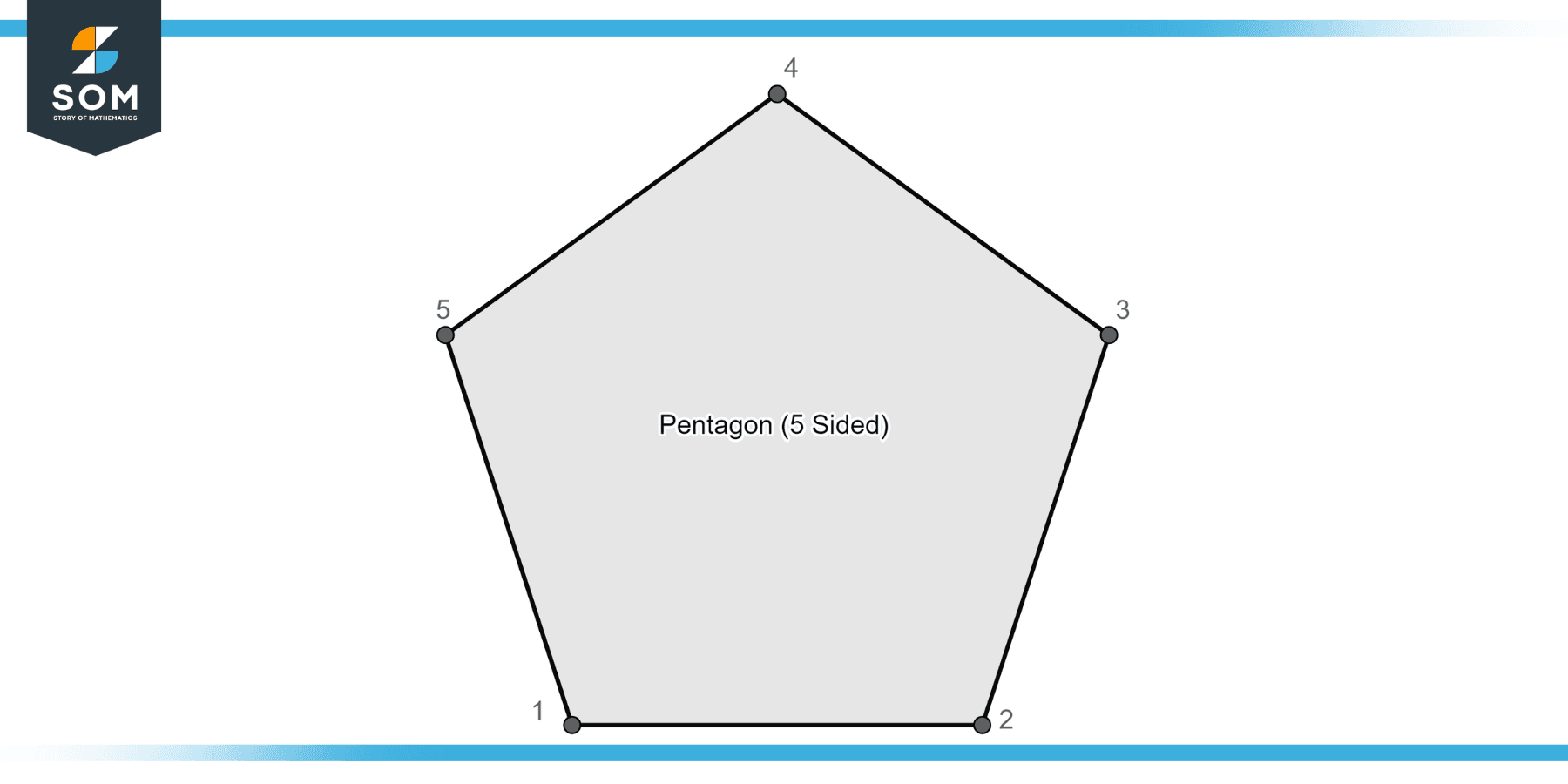
Figure-1: Generic pentagon.
Pentagons are commonly found in various contexts, including architecture, design, and mathematics. In architecture, they can be seen in the design of buildings such as the Pentagon in Washington, D.C., which is a famous five-sided structure. The Pentagon is also utilized in mathematical concepts, such as the Pentagonal Number series, it stands for the maximum possible number of dots that can be arranged to form a pentagon.
Origins and Significance of the Pentagon Shape
The pentagon shape has a rich historical background that traces back to ancient civilizations. Dating back thousands of years, the shape of the Pentagon holds cultural, mystical, and symbolic significance in various cultures and societies. The origins of its significance can be found in religious, architectural, and mathematical contexts, where the number five and its associated shape held special meaning.
Ancient Civilizations and the Pentagon Shape
In ancient Greece, the Pentagon shape was revered for its connection to the divine. The Pythagoreans associated it with the concept of the Golden Ratio, a mathematical proportion believed to represent perfect beauty and harmony. In Chinese philosophy, the five-sided shape symbolizes the five elements of nature: fire, earth, metal, water, and wood, representing balance and cosmic unity. Additionally, ancient Mayan and Aztec civilizations incorporated the Pentagon shape into their artwork, architecture, and calendar systems, depicting their understanding of the universe’s interconnectedness.
Modern Symbolism and Usage of the Pentagon Shape
The Pentagon’s shape gained renewed prominence in modern times, particularly with its association with military and defense. The geometric design of the Pentagon building, constructed during World War II, drew inspiration from the Pentagon shape. Its strategic importance led to the name “Pentagon” and further popularized the shape in contemporary culture.
Pentagon Shape in Architecture and Design
The pentagon shape has found its way into modern architecture, design, and even pop culture. Architects and designers have employed the shape in the creation of buildings, facades, and urban landscapes, seeking to evoke strength, stability, and a sense of importance. Its clean lines and distinct geometry make it visually striking and memorable.
The Pentagon Shape’s Enduring Legacy
The historical significance of the Pentagon shape lies in its timeless appeal and enduring symbolism. From ancient civilizations to the modern era, its geometric form has represented various concepts, including divinity, balance, military strength, and architectural splendor. Today, the Pentagon shape continues to be recognized globally, its historical background serving as a reminder of the profound influence of geometry on human culture, art, and design.
Properties
Number of Sides
A pentagon has five sides. These sides are straight line segments that connect to form a closed shape.
Number of Angles
A pentagon has five angles. Each angle is formed by two adjacent sides. A pentagon’s internal angles always add up to 540 degrees. This means that if you add up all the angles inside a pentagon, the total will always be 540 degrees.
Angle Measure
Since a pentagon has five angles, each angle measures 108 degrees. This is because the sum of the interior angles (540 degrees) is divided equally among the five angles.
Symmetry:
A pentagon exhibits symmetry. It can be divided into five equal isosceles triangles. An isosceles triangle has two sides of equal length and two angles of equal measure.
Diagonals
The diagonals of a pentagon are line segments that connect non-adjacent vertices. In a pentagon, there are five diagonals. Diagonals divide the Pentagon into internal triangles.
Regular and Irregular Pentagons
A regular pentagon has equal side lengths and equal interior angles. All the angles in a regular pentagon are 108 degrees, and all the sides are of the same length. An irregular pentagon has different side lengths and angles.
Golden Ratio
The golden ratio, approximately equal to 1.618, is closely associated with regular pentagons. It is the ratio between the length of the diagonal and the length of a side of a regular pentagon.
Construction
A pentagon can be constructed using various methods, such as using a compass and straightedge or utilizing geometric principles like the Pythagorean theorem.
Related formulas
The perimeter of a Regular Pentagon
The perimeter (P) of a regular pentagon can be calculated by multiplying the length of one side (s) by 5 since a regular pentagon has five equal sides. P = 5s
Interior Angle of a Regular Pentagon
The interior angle (I) of a regular pentagon can be calculated using the formula: I = (5 – 2) × 180° / 5 A = 108°
Exterior Angle of a Regular Pentagon
The exterior angle (E) of a regular pentagon can be calculated using the formula: E = 360° / 5 E = 72°
Apothem of a Regular Pentagon
The distance from a regular Pentagon’s centre to any of its sides’ midpoints is known as the apothem (a). The apothem can be calculated using the following formula, where s is the length of a side and R is the radius of the circumscribed circle: a = R × cos(36°). Alternatively, the apothem can be calculated using the formula: a = s / (2 × tan(54°))
Area of a Regular Pentagon
You may determine the regular pentagon’s area (A) by multiplying the apothem (a) by the perimeter (P) and dividing the result by 2: A = (P × a) / 2. Alternatively, the area can also be calculated using the formula: A = (s² × 5) / (4 × tan(54°))
These formulas are applicable specifically to regular pentagons, where all sides and angles are equal. For irregular pentagons with varying side lengths and angles, specific measurements and calculations may vary.
Pentagon Types
Regular Pentagon
A regular pentagon is a type of Pentagon that has equal side lengths and equal interior angles. All five angles in a regular pentagon measure 108 degrees. The regular Pentagon possesses rotational symmetry of order 5, meaning that it looks the same after rotating it by multiples of 72 degrees. Examples of regular pentagons can be found in the shape of a star, where the outer points form the vertices of the Pentagon. Below is the generic diagram of a regular pentagon.
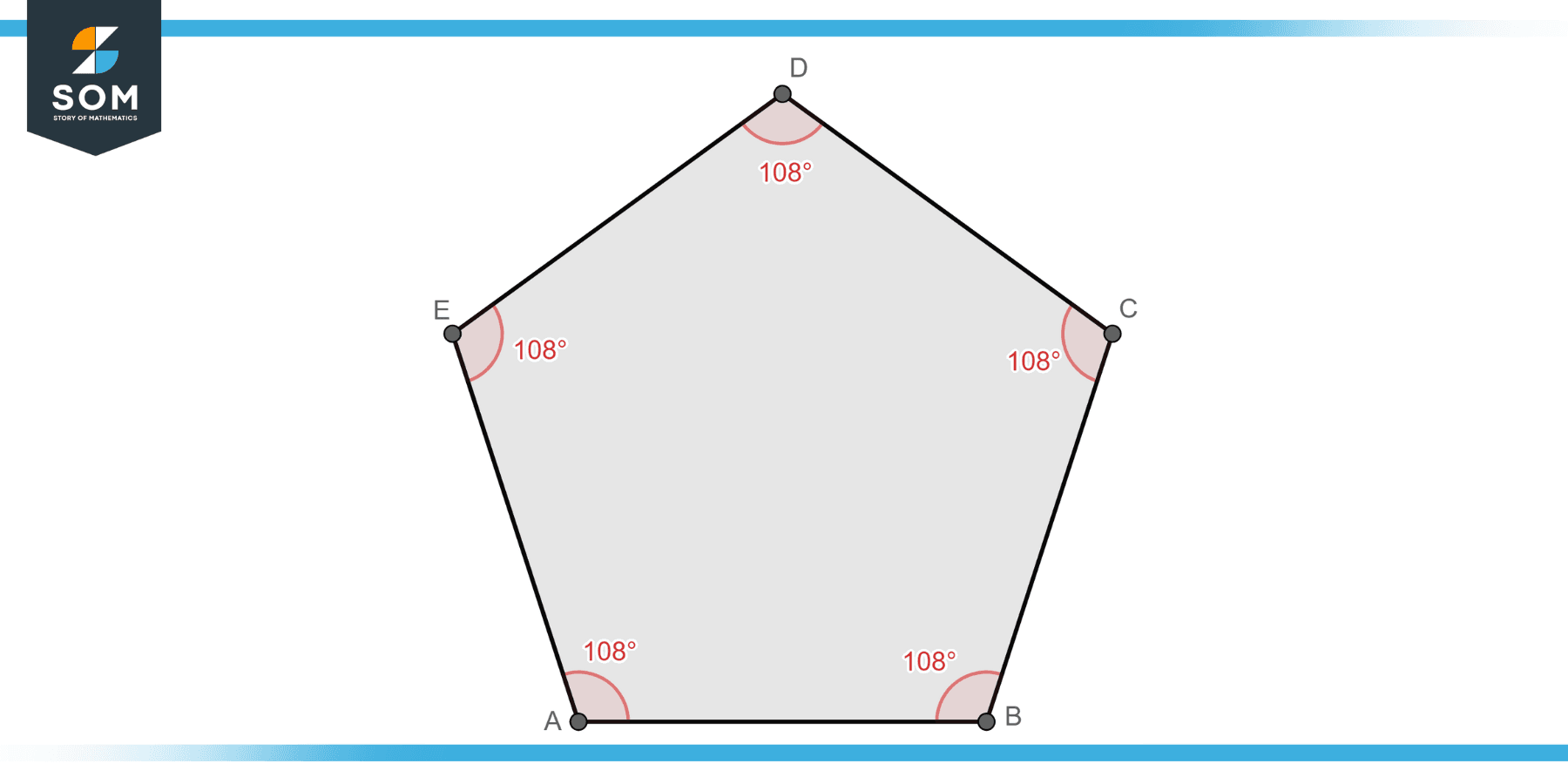
Figure-2: Regular pentagon.
Irregular Pentagon
An irregular pentagon is a pentagon that does not have equal side lengths or equal angles. In an irregular pentagon, the lengths of its sides and the measures of its angles can differ. Irregular pentagons can take on various shapes and configurations, and their angles can range from acute to obtuse. Below is the generic diagram of an irregular pentagon.
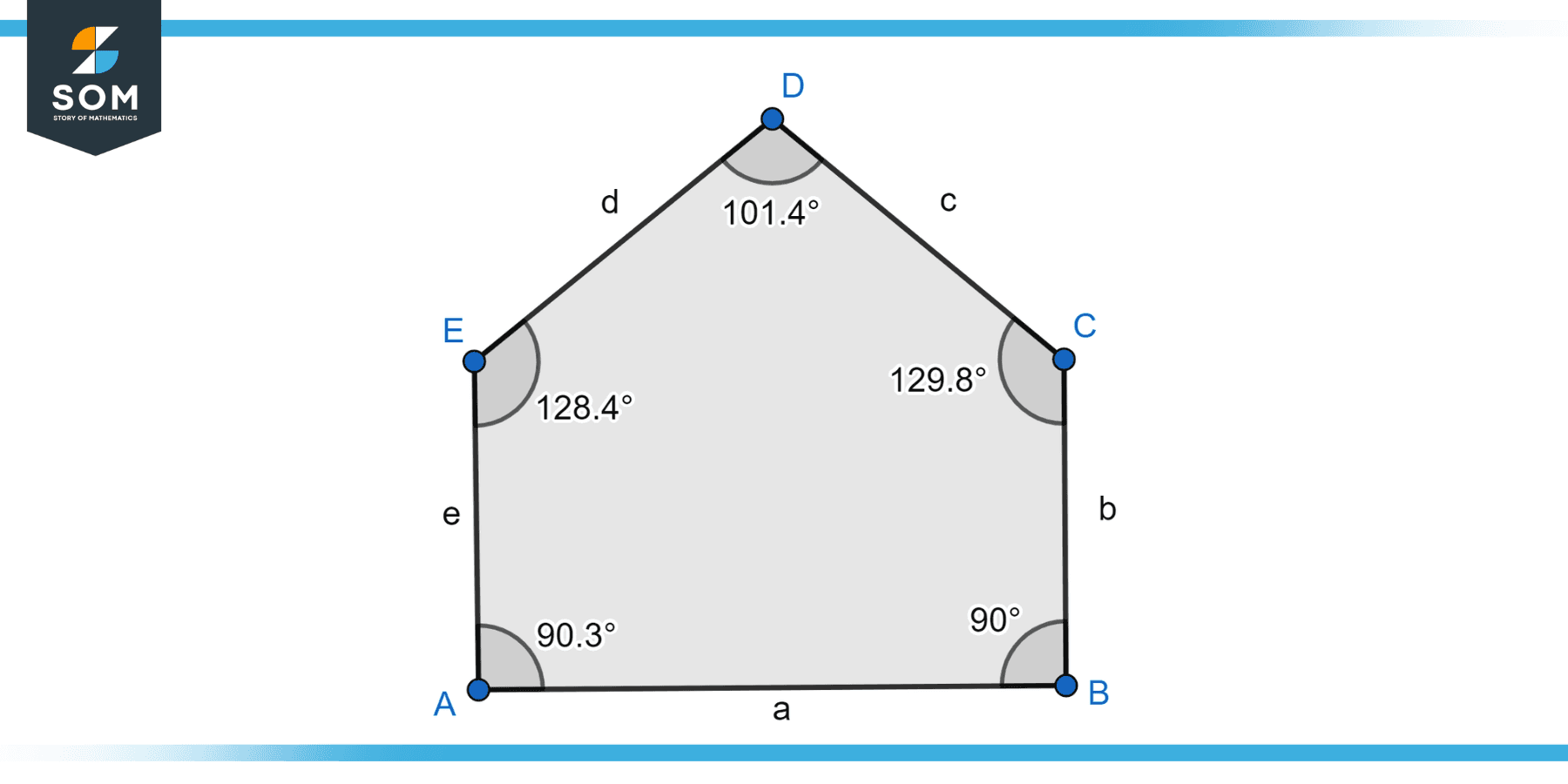
Figure-3: Irregular pentagon.
Convex Pentagon
Any pentagon whose internal angles are all smaller than 180 degrees is indeed considered convex. Convex pentagons have a bulging shape and do not have any dents or concave parts. The sides of a convex pentagon do not intersect when extended. Thank you for pointing that out.Below is the generic diagram of an irregular convex pentagon.
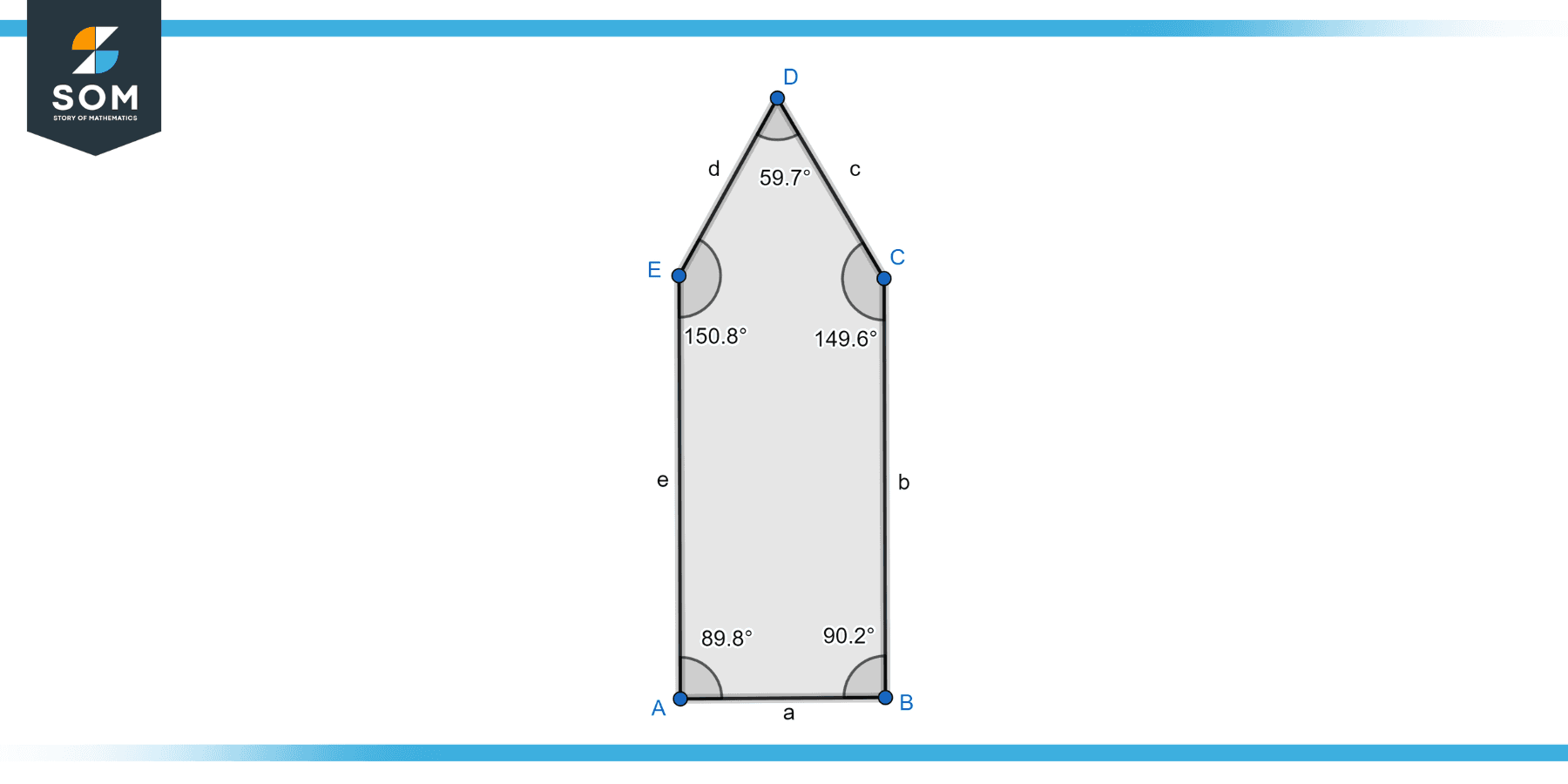
Figure-4: Irregular convex pentagon.
Concave Pentagon
A pentagon with at least one internal angle greater than 180 degrees is indeed said to be concave. In a concave pentagon, some of its sides intersect when extended, creating inward “dents” or concave parts. Concave pentagons can have a variety of shapes, and their angles can range from acute to reflex. Below is the generic diagram of an irregular concave pentagon.
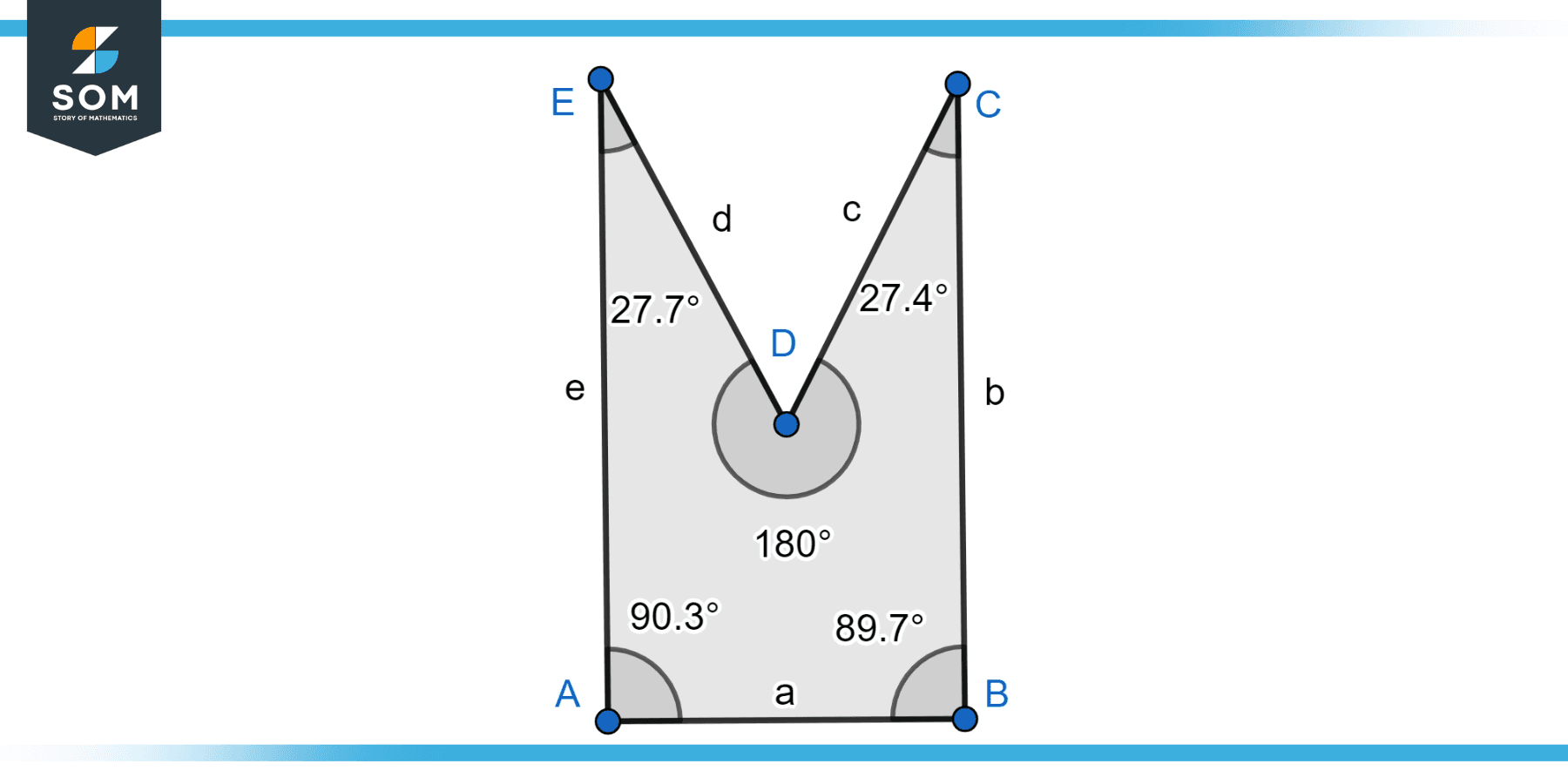
Figure-5: Irregular concave pentagon.
Golden Pentagon
A golden pentagon, also known as a golden ratio pentagon, is a regular pentagon with a unique relationship between the length of its diagonal and its side length. The ratio of the diagonal length to the side length in a golden pentagon is approximately equal to the golden ratio, which is approximately 1.618. The golden pentagon is considered aesthetically pleasing and is often associated with harmonious proportions.
Applications
Pentagons find applications in various fields due to their unique properties and aesthetic appeal. Here are some notable applications of pentagons in different areas.
Architecture and Design
Pentagons are indeed frequently used in architecture and design for their distinct shape and symmetry. The Pentagon building in Washington, D.C., serves as an iconic example of a pentagon-shaped structure. Additionally, pentagons can be found in the design of facades, windows, tiles, and decorative elements in various buildings. The unique characteristics of the pentagon shape make it a popular choice for creating visually appealing architectural and design elements.
Mathematics and Geometry
Pentagons do indeed play a significant role in mathematics and geometry. They are commonly used as illustrative examples in geometry textbooks, providing a foundation for studying polygonal shapes. Properties of pentagons, such as their angles, diagonals, and side lengths, are explored in mathematical proofs and calculations. The study of pentagons contributes to a deeper understanding of geometric principles and serves as a building block for more complex mathematical concepts.
Art and Aesthetics
Pentagons are indeed visually appealing and are frequently used in art and aesthetics. Artists and designers incorporate pentagon shapes in paintings, sculptures, patterns, and various artistic compositions. The regular pentagon, with its symmetrical angles and sides, often represents balance and harmony in visual art. The distinct geometry of the pentagon shape offers artists a versatile and engaging element to incorporate into their creative expressions.
Tessellations and Patterns
Pentagons are indeed used in tessellations, which are repeating patterns that cover a plane without any gaps or overlaps. Pentagonal tessellations can be found in various contexts, including Islamic art, tiling designs, and mathematical investigations. Artists and designers utilize pentagons to create intricate patterns and achieve visually captivating arrangements within tessellations. The unique properties of pentagons allow for the creation of diverse and aesthetically pleasing tessellation designs.
Crystallography
In crystallography, which is the study of crystal structures, pentagons can indeed be observed in certain types of crystals. For instance, dodecahedral crystals have twelve pentagonal faces, while icosahedral crystals have twenty triangular faces, some of which contain embedded pentagons. These unique crystal structures with pentagonal elements contribute to the diverse and fascinating world of crystallography, revealing the natural occurrence of pentagon shapes in the formation of crystals.
Chemistry
In organic chemistry, pentagons are indeed encountered in the study of carbon-based compounds known as aromatic hydrocarbons. Pentagonal rings, such as in the case of cyclopentane or pentagonal aromatic molecules like pentalene, have unique electronic properties and are studied for their reactivity and stability.
Sports
Pentagons do indeed find applications in various sports equipment designs. For instance, soccer balls (also known as footballs) traditionally consist of pentagonal and hexagonal panels stitched together to form a spherical shape. This pattern of pentagons and hexagons provides stability and uniform distribution of pressure on the ball’s surface.
Logo Design and Branding
Pentagons are indeed often used in logo designs and branding to convey certain meanings or characteristics. Companies may incorporate pentagons in their logos to symbolize strength, stability, innovation, or a sense of geometric precision. The distinctive shape of a pentagon can make a logo visually striking and memorable.
Exercise
Example 1
Determine the surface area and circumference of a regular pentagon with 6 cm sides.
Solution
Given: Side length (s) = 6 cm
To find the perimeter (P), we can use the formula P = 5 × s since a regular pentagon has five equal sides: P = 5 × 6 cm P = 30 cm.
To find the area (A), we can use the formula:
A = (s² × 5) / (4 × tan(54°))
A = 6² × 5 / (4 × tan(54°))
A ≈ 61.88 cm² (rounded to two decimal places)
Example 2
Determine the measure of each interior angle of a regular pentagon.
Solution
To find the measure of each interior angle (A), we can use the formula
A = (5 – 2) × 180° / 5
A = (5 – 2) × 180° / 5
A = 108°
Therefore, a regular pentagon has 108° for each inner angle.
Example 3
Measure each of the outer angles of a standard pentagon.
Solution
To determine each exterior angle’s (E) measurement, we can use the formula
E = 360° / 5
E = 360° / 5
E = 72°
Therefore, each exterior angle of a regular pentagon measures 72°.
Example 4
Find the apothem of the pentagon given in Figure-6.
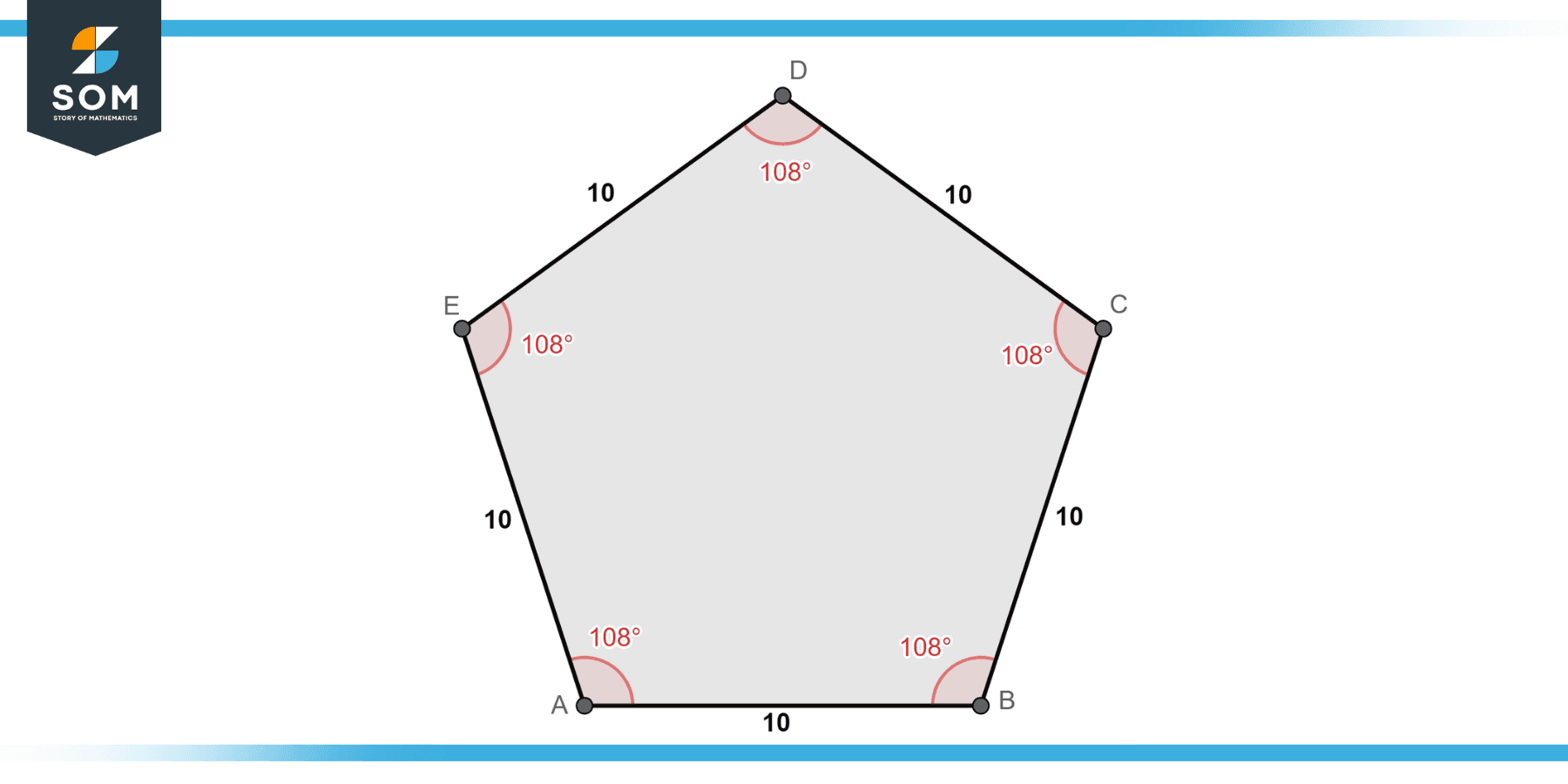
Figure-6.
Solution
Given: Side length (s) = 10 units
To find the apothem (a), we can use the formula
a = s / (2 × tan(54°))
a = 10 units / (2 × tan(54°))
a ≈ 5.07 units (rounded to two decimal places)
Therefore, the apothem of the regular Pentagon is approximately 5.07 units.
Example 5
Determine the radius of the circumscribed circle for a regular pentagon with an apothem of 8 cm.
Solution
Given: Apothem (a) = 8 cm
To find the radius of the circumscribed circle (R), we can use the formula
R = a / cos(36°)
R = 8 cm / cos(36°)
R ≈ 9.76 cm (rounded to two decimal places)
Therefore, the radius of the circumscribed circle for the regular Pentagon is approximately 9.76 cm.
Example 6
Find the area of a regular pentagon with an apothem of 12 units.
Solution
Given: Apothem (a) = 12 units
To find the area (A), we can use the formula
A = (P × a) / 2
where P is the perimeter of the Pentagon:
P = 5s (where s is the side length of the Pentagon).
Since the Pentagon is regular, all sides are equal, so let’s assume s = 1 unit (this is arbitrary for calculation purposes).
P = 5 × 1 unit
P = 5 units
A = (P × a) / 2
A = (5 units × 12 units) / 2
A = 30 units²
Therefore, the area of the regular Pentagon is 30 square units.
Example 7
Determine the length of a side of a regular pentagon with a perimeter of 40 cm.
Solution
Given: Perimeter (P) = 40 cm
To find the length of each side (s), we can rearrange the formula
P = 5 × s and solve for s:
40 cm = 5 × s
s = 40 cm / 5
s = 8 cm
Therefore, each side of the regular Pentagon measures 8 cm.
Example 8
Calculate the ratio of the area of a regular pentagon to the area of its circumscribed circle.
Solution
To calculate the ratio of the area of a regular pentagon to the area of its circumscribed circle, we need to consider their formulas.
The area (A) of a regular pentagon can be calculated using the formula A = (s² × 5) / (4 × tan(54°)), where s is the side length of the Pentagon.
The area (C) of the circumscribed circle can be calculated using the formula C = πR², where R is the radius of the circumscribed circle.
Since the radius of the circumscribed circle is equal to the apothem (a) of the Pentagon, the formula becomes C = πa².
The ratio of the area of the Pentagon to the area of the circle is then A / C.
This ratio depends on the specific values of s and a.
Example 9
Determine the number of diagonals in a pentagon.
Solution
A diagonal is a line segment that connects non-adjacent vertices in a polygon.
In a pentagon, each vertex is connected to three non-adjacent vertices by diagonals.
Since a pentagon has 5 vertices, the total number of diagonals is 5 × 3 = 15.
However, we must divide by 2 to avoid counting each diagonal twice (as it connects two vertices).
Therefore, a pentagon has 15 / 2 = 7.5 diagonals (note that diagonals must be whole numbers, so we round down).
Therefore, a pentagon has 7 diagonals.
All images were created with GeoGebra.
